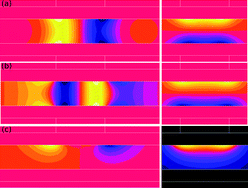Magnetic forces produced by rectangular permanent magnets in static microsystems†
Abstract
Finite element numerical simulations were carried out in 2D geometries to map the magnetic field and force distribution produced by rectangular permanent magnets as a function of their size and position with respect to a microchannel. A single magnet, two magnets placed in attraction and in repulsion have been considered. The goal of this work is to show where magnetic beads are preferentially captured in a microchannel. These simulations were qualitatively corroborated, in one geometrical case, by microscopic visualizations of magnetic bead plug formation in a capillary. The results show that the number of plugs is configuration dependent with: in attraction, one plug in the middle of the magnets; in repulsion, two plugs near the edges of the magnets; and with a single magnet, a plug close to the center of the magnet. The geometry of the magnets (h and l are the height and length of the magnets respectively) and their relative spacing s has a significant impact on the magnetic flux density. Its value inside a magnet increases with the h/l ratio. Consequently, bar magnets produce larger and more uniform values than flat magnets. The l/s ratio also influences the magnetic force value in the microchannel, both increasing concomitantly for all the configurations. In addition, a zero force zone in the middle appears in the attraction configuration as the l/s ratio increases, while with a single magnet, the number of maxima and minima goes from one to two, producing two focusing zones instead of only one.


 Please wait while we load your content...
Please wait while we load your content...